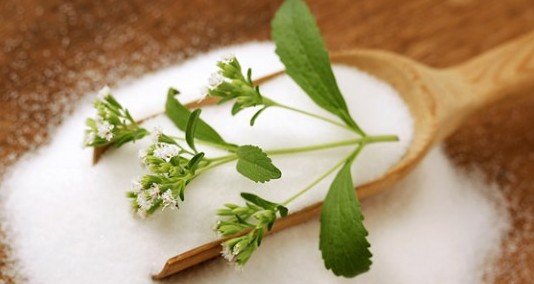
Stevia rebaudiana is one of the two species that has innate ability to produce sweet. It is comparatively easy-to-grow – a herb in the chrysanthemum family termed as Stevia rebaudiana which is usually known as sweater leaf in common language. Primitively primal to South America, stevias leaves have been used for centuries by native peoples in Paraguay and Brazil to sweeten beverages. Stevia is now being cultivated in Asia, North and South America. Its commercial cultivation is started in many countries including India. The big producers of Stevia are Japan, China, Korea, Brazil, Malaysia, Taiwan, Thailand and Paraguay. Presently, Stevia is consumed in Japan, Korea, Brazil, the United States of America, Argentina, Canada, China, and in Paraguay.
Stevia is an upright growing plant which can grow up to 30 cm tall before it starts to set flowers. The leaves are green in color, grow in pairs and their width varies from 2.5 to 3.5 cm while the length can be up to 6 cm. The flowers are typically white in color and are hermaphrodite. Normally, the time of flowering is in autumn. The root system is trivial with some lateral roots developed and it is sensitive to drought stress and strong windy conditions. Matured seed is black and very small. The weight of a thousand seeds of the plant ranges from 0.5-1.0 gram. The yield and vigor of the seed are influenced by the growth conditions during fertilization.
Stevia has the capability to adapt many dissimilar climates. Plants need ample rainfall, temperature averaging 15º to 35 ºC, rich loamy, and well drained soils are ideal for its growth. Pakistan has very unlike weather conditions from much cold (below 0°C) in winter to much hot (above 48°C) during summer season. So we have a full capacity for commercial production of sugar substitute Stevia plant. There are many features of Stevia that make it an apotheosis crop to grow. It is a perennial plant which has an unparalleled ability to regain after frost stress. Harvested parts are leaves and three to four cutting per year are possible. During the plants initial growing period Inter-cropping may be done.
Initially, the land should be ploughed to gain a fine tilth of soil for Stevia cultivation. Best and economical way to grow Stevia is to form raised bed of height half feet and of 3 to 4 feet wide. Plant population should be around 50,000 plants per acre. Best way to irrigate plants is micro sprinklers which can be used to sprinkle the water once in a day in winter and 4 times in a day in summer. Any organic mulch can be used to ensure moist soil. Good compost can live up to fertilizers requirements. Weeds can be removed by manually. Perennial plant can be sustained economical for 375 years with good management skills. Stevia carries small white flowers in the fall. At this stage, the plant stretches out and proffers good leaves for harvest. Leaves are economical parts which are harvested by plucking the leaves. The entire plant with the side branches is cut leaving 10-15 cm from the base.
Stevioside, the main constituent of plant, is fortunately calorie-free and breathtakingly 300 times sweeter than table sugar. In spite of its use as alternate of sweat; Stevia has been used medicinally for over 1500 years as a traditional remedy for diabetes and gum disease. Independent scientific studies of Stevia show that it may surely improve the function of cells required for insulin production in the pancreas. It also improves glucose tolerance in people with diabetes. This spectacular herb is not a carbohydrate, therefore it is safe for diabetics and unlike other sweeteners it does not promote the development of intestinal parasites. It has been reported to possess anti-viral properties. Preliminary evidence suggests Stevia also possesses blood pressure lowering properties and may be a useful treatment for hypertension.
Climatically, Pakistan can be the center for cultivation, of Stevia. Moreover, it has been approximated that 6.2 million people have diabetes in Pakistan, which will ascend to 11.6 million by 2025. Pakistan itself requires Stevia for its own cure and intake. Only 5-6 plants can satisfy the annual needs of a family of 6-8 persons of our country.
Globally and in Pakistan, in spite of heavy inputs like irrigation water and nutrients with high cost of production yields of sugar crops are low coupled with very low sugar contents. Sugar leaf is one of the most profitable crops for the forthcoming days because of increasing demand of calorie free alternate of the sugar. Therefore, most rationalized, effectual and frugal approach to supplement sugar industry is to develop production technology of non-traditional sweeteners like Stevia at commercial scale that would be responsive under low input conditions. There are some medical issues with its constant use which can be avoided through plant breeding by producing such verities. Now it is up to agri-scientists to expand research and create knowingness among farmers to cultivate such a charming plant because now this industry is an opportunity. In a few years game will be only for the old players to play.